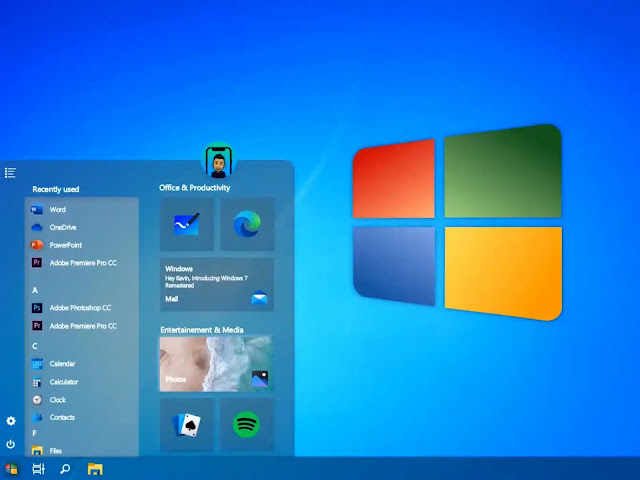Windows 7:
In the realm of computing history, Windows 7 stands as a monumental release, a pinnacle achievement in the lineage of the Windows NT operating system, meticulously crafted by the tech giant Microsoft. The significance of this operating system's emergence on the global stage is underscored by its official manufacturing release date of July 22, 2009, a date that would go on to etch its name in the annals of technology forever. The curtain of availability was raised on October 22, 2009, marking the commencement of a new era in computing prowess.
A Triumph Over Predecessors
Heralding the dawn of a new era, Windows 7 rose to prominence as the triumphant successor to the previously unveiled Windows Vista, an epoch where Microsoft demonstrated its dedication to enhancing user experiences and refining system functionalities. The chronicle of Windows 7's release follows in the footsteps of Windows Vista, with a mere three-year gap. Windows 7 held its forte as an operating system tailored for personal computing, spanning a spectrum of devices including home computers, business desktops, laptops, tablet PCs, and the innovative media center PCs, a true embodiment of versatility.
Seamless Synchrony: Windows 7 and Windows Server 2008 R2
Windows 7's grand debut was a synchronized spectacle, arriving alongside its server counterpart, Windows Server 2008 R2. The parallel unveiling showcased Microsoft's commitment to delivering a comprehensive ecosystem that catered to both personal and enterprise domains, cementing its role as an architect of seamless digital landscapes.
The Evolution and The Aftermath
The Windows 7 narrative, although remarkable, eventually found its successor in the form of Windows 8, an event that transpired in November 2012. The legacy of Windows 7 endured for over three years, leaving an indelible mark on the digital horizon. The journey concluded with the cessation of extended support on January 14, 2020, a testament to the lasting impact and widespread adoption that Windows 7 had garnered.
Evolution in Design and Functionality
Windows 7 did not merely hold the torch; it innovatively illuminated the way forward. Building upon its predecessor's foundation, it unveiled a reimagined user interface, the Windows Aero, exquisitely polished and augmented. Among the notable additions was the redesigned taskbar, offering a hub for pinned applications and granting users newfound control over their digital workspace. A symphony of window management features harmonized to empower multitasking with finesse.
Empowering Features
Microsoft ingeniously equipped Windows 7 with an arsenal of empowering features. Libraries emerged as a beacon of organization, simplifying data management through their systematic architecture. The revolutionary HomeGroup file-sharing system fostered seamless connectivity, allowing users to orchestrate the symphony of their digital lives effortlessly. Multitouch input support beckoned a tactile dimension, revolutionizing interactions with computing devices.
A Secure Haven: Action Center and Beyond
The innovation did not stop at the surface; Windows 7 fortified itself with the introduction of the "Action Center." This centralized haven provided a panoramic view of system security and maintenance intricacies, effectively transforming the user into the captain of their digital ship. Windows 7 endeavored to enhance the User Account Control system, sculpting it into a less intrusive companion that harmonized user experience and system security.
Pinnacle of Performance
Windows 7 was more than its predecessors combined; it was an orchestration of technology's finest. Bundled with this opus were upgraded iterations of quintessential applications. Internet Explorer 8 ventured to redefine the browsing experience, while Windows Media Player serenaded media enthusiasts with enhanced capabilities. Windows Media Center curated entertainment realms, showcasing Microsoft's commitment to an all-encompassing digital symphony.
Windows 7 was not merely an evolution; it was a harmonious symphony of compatibility and adaptability. It bridged the gap between the past and the present, seamlessly embracing legacy software and hardware while propelling users into the future. This mastery of transition solidified Windows 7's reputation as a versatile companion, catering to both the nostalgic and the progressive.A Flourish of Compatibility and Adaptability
An innovative navigation experience beckoned with the advent of libraries, an organizational marvel that transformed content management. Users reveled in the power to consolidate disparate files and folders into virtual hubs, eradicating the chaos of digital clutter. But the true marvel lay in the HomeGroup, a collaborative masterpiece that eased the choreography of sharing files, printers, and media across the digital landscape.Navigating a Digital Cosmos: Libraries and HomeGroup
Windows 7 ventured into the realm of tactile interaction, introducing multitouch input to the digital canvas. The age-old boundaries between human and machine blurred as users engaged with their devices through gestures and swipes. From zooming into images with a pinch to navigating maps with a flick, the canvas of Windows 7 embraced touch as a language, unlocking a new dimension of engagement.A Canvas of Touch: Multitouch Input
A sentinel of security emerged with the introduction of the "Action Center." Windows 7 elevated system vigilance to an art form, presenting users with a unified hub to oversee security and maintenance. This fortress of knowledge empowered users, rendering them privy to system health and threat mitigation. Windows 7 went beyond aesthetics; it enveloped users in a shield of digital protection.Sentinel of Security: Action Center and Beyond
Windows 7 was more than an operating system; it was a canvas for application innovation. Internet Explorer 8 cast a new light on browsing, crafting a safer and more efficient online voyage. Windows Media Player serenaded users with enhanced playback capabilities and media management. The curtain rose on Windows Media Center, an entertainment haven where users could orchestrate their media experiences with precision.A Symphony of Revamped Applications
As the digital world evolves, Windows 7's legacy endures, a testament to innovation's timelessness. Its footprint lingers in the hearts of those who experienced its transformative power, shaping their digital expectations and experiences. Windows 7 stands not just as an operating system, but as a benchmark for excellence, a tale of how technology can elevate and empower lives.The Legacy Endures





No comments:
Post a Comment